2000 | OriginalPaper | Chapter
Health Effects of a Household Waste Incinerator Near Wilrijk, Belgium
Author : N. Van Larebeke
Published in: Health Impacts of Waste Management Policies
Publisher: Springer Netherlands
Included in: Professional Book Archive
Activate our intelligent search to find suitable subject content or patents.
Select sections of text to find matching patents with Artificial Intelligence. powered by
Select sections of text to find additional relevant content using AI-assisted search. powered by
In Wilrijk, Flanders, a cluster of congenital anomalies was discovered amongst inhabitants of the Neerland neighbourhood, situated between the municipal waste incinerator IHK at Edegem (at a distance of about 800 metres) and IS VAG at Wilrijk (at a distance of about 1200 metres). This paper is an overview of the results of health impact studies on these inhabitants during the period 1997–1998. Chromosomal aberrations in peripheral lymphocytes were studied in twenty-four children from Neerland, as compared to twenty children from another neighbourhood in the Antwerp region. No difference was found. Negative confounding might have resulted from the fact that the twenty-four children in the Neerland neighbourhood had six smoking parents, whereas the twenty children in the control group had seventeen smoking parents. The study did not allow for a slight increase in chromosome aberrations. Another study found no difference between the whole of Flanders and the Neerland neighbourhood as to perinatal death. There was, however, a statistically non-significant difference in the incidence of congenital malformations, with an odds ratio of 1.26 (0.80–1.99), confined to children born from parents who had not resided for a long time in Neerland. There was also a statistically significant increase in the number of multiple pregnancies, with an odds ratio of 2.60 (2.08–3.31). Compared to other neighbourhoods in Wilrijk and to Flanders in general, occurrence of failure at school was not increased in Neerland, and there were significantly less children from the Neerland neighbourhood in special education classes. In the third class of maternal school, but not in the first year of maternal school nor in the third year of primary school, allergies and repeated episodes of the common cold were significantly more frequent in children from Neerland than in children from nearby Hemiksem.It is concluded that although in this population, there is no definitive evidence for the impact of the incinerator emissions on human health, the data are sufficiently indicative to advocate: detailed studies on individual exposure and presymptomatic effects,a basic need for chemical hygiene, comparable to the microbiological hygiene which has been cultivated in industrialised societies for more than a century.
